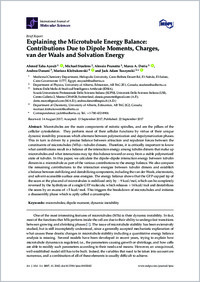Explaining the microtubule energy balance : contributions due to dipole moments, charges, van der Waals and solvation energy
- Ayoub, Ahmed Taha Medicinal Chemistry Department, Heliopolis University, Cairo-Belbeis Desert Rd, El-Nahda, El-Salam, Cairo Governorate 11777, Egypt
- Staelens, Michael Department of Physics, University of Alberta, Edmonton, AB T6G 2E1, Canada
- Prunotto, Alessio Istituto Dalle Molle di studi sull'intelligenza artificiale (IDSIA), Facoltà di scienze informatiche, Università della Svizzera italiana, Svizzera
- Deriu, Marco A. Istituto Dalle Molle di studi sull'intelligenza artificiale (IDSIA), Facoltà di scienze informatiche, Università della Svizzera italiana, Svizzera
- Danani, Andrea Istituto Dalle Molle di studi sull'intelligenza artificiale (IDSIA), Facoltà di scienze informatiche, Università della Svizzera italiana, Svizzera
- Klobukowski, Mariusz Department of Chemistry, University of Alberta, Edmonton, AB T6G 2G2, Canada
- Tuszynski, Jack Adam Department of Physics, University of Alberta, Edmonton, AB T6G 2E1, Canada
-
22.09.2017
Published in:
- International journal of molecular sciences. - 2017, vol. 18, no. 10, p. 2042
English
Microtubules are the main components of mitotic spindles, and are the pillars of the cellular cytoskeleton. They perform most of their cellular functions by virtue of their unique dynamic instability processes which alternate between polymerization and depolymerization phases. This in turn is driven by a precise balance between attraction and repulsion forces between the constituents of microtubules (MTs)—tubulin dimers. Therefore, it is critically important to know what contributions result in a balance of the interaction energy among tubulin dimers that make up microtubules and what interactions may tip this balance toward or away from a stable polymerized state of tubulin. In this paper, we calculate the dipole–dipole interaction energy between tubulin dimers in a microtubule as part of the various contributions to the energy balance. We also compare the remaining contributions to the interaction energies between tubulin dimers and establish a balance between stabilizing and destabilizing components, including the van der Waals, electrostatic, and solvent-accessible surface area energies. The energy balance shows that the GTP-capped tip of the seam at the plus end of microtubules is stabilized only by −9 kcal/mol, which can be completely reversed by the hydrolysis of a single GTP molecule, which releases +14 kcal/mol and destabilizes the seam by an excess of +5 kcal/mol. This triggers the breakdown of microtubules and initiates a disassembly phase which is aptly called a catastrophe.
- Language
-
- English
- Classification
- Biological sciences
- License
- Open access status
- gold
- Identifiers
-
- RERO DOC 328297
- DOI 10.3390/ijms18102042
- ARK ark:/12658/srd1319002
- Persistent URL
- https://n2t.net/ark:/12658/srd1319002
Statistics
Document views: 204
File downloads:
- Texte intégral: 153
